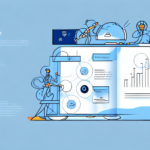Understanding KPI (Key Performance Indicator) and Its Benefits
Key Performance Indicators (KPIs) are essential tools that businesses use to measure performance and track progress towards their goals. According to ShipScience, KPIs provide a way to monitor specific aspects of a business that are critical to its success. By defining and measuring these indicators, a business can track its performance and make data-driven decisions to improve its operations and profitability. In this article, we will explore the benefits of KPIs, different types of KPIs, how to set realistic KPI targets, and best practices for tracking and reporting on KPI performance.
Why KPIs Are Important for Business Success
As businesses grow, tracking performance becomes increasingly critical to ensuring success. Without a concrete way to measure progress, it is impossible to know whether the business is moving in the right direction. KPIs provide a way to measure success across different functions of the business, such as marketing, sales, operations, and finance. By monitoring KPIs, businesses can make informed decisions about resource allocation and strategy.
Moreover, KPIs help businesses identify areas that need improvement and set achievable goals. For instance, if a business's KPI for customer satisfaction is low, it can focus on improving customer service to increase satisfaction levels. According to a study by Harvard Business Review, companies that effectively use KPIs are 5x more likely to achieve their strategic goals. KPIs also enable businesses to track their performance over time and compare it to industry benchmarks. This helps businesses stay competitive and adapt to changing market conditions.
Different Types of KPIs and How to Choose the Right Ones for Your Business
There are many different types of KPIs, ranging from financial metrics to operational metrics. For a KPI to be effective, it must be relevant to the business's objectives and aligned with the company’s mission and vision. When choosing KPIs, it is crucial to consider which aspects of the business are most critical to success. Some examples of common KPIs include:
- Revenue Growth: Measures the increase in a company's sales over a specific period.
- Customer Satisfaction: Assesses how products or services meet or surpass customer expectations.
- Employee Productivity: Evaluates the efficiency of employees in generating output.
- Inventory Turnover: Indicates how often inventory is sold and replaced over a period.
- Website Traffic: Tracks the number of visitors to a website.
The specific KPIs a business chooses will depend on its goals and priorities. One important consideration when selecting KPIs is to ensure that they are measurable and quantifiable. This means that the KPIs should be based on data that can be tracked and analyzed over time, allowing the business to monitor progress towards its goals and make adjustments as needed.
Another factor to consider when choosing KPIs is to ensure that they are actionable. This means that the KPIs should be tied to specific actions that the business can take to improve performance. For example, if a business is tracking customer satisfaction, it should have a plan in place to address any issues that arise and improve the customer experience.
How to Set Realistic KPI Targets and Measure Progress Towards Them
To be effective, KPIs must be specific, measurable, achievable, relevant, and time-bound (SMART). Setting realistic targets is critical to ensuring that KPIs are attainable and help to drive performance. Establishing a baseline for each KPI ensures that a business can track its progress over time. According to Inc., businesses that set SMART KPIs are 30% more likely to achieve their objectives.
Here are steps to set realistic KPI targets:
- Define Clear Objectives: Understand what you aim to achieve with each KPI.
- Gather Relevant Data: Use historical data to inform target setting.
- Consult Stakeholders: Involve key team members to ensure targets are realistic.
- Set Time Frames: Determine specific periods for achieving each KPI.
- Review and Adjust: Regularly assess progress and make necessary adjustments.
Ongoing measurement and analysis of KPIs can inform adjustments to strategy and tactics to improve performance over time. It is important to regularly review and update KPI targets to ensure they remain relevant and aligned with business goals. This can be done by analyzing industry trends, competitor performance, and internal data. Additionally, involving key stakeholders in the KPI setting process can increase buy-in and accountability for achieving targets. By regularly monitoring and adjusting KPIs, businesses can stay agile and responsive to changes in the market and internal operations.
The Role of KPIs in Improving Employee Performance and Productivity
Effective KPIs can motivate employees to improve performance by focusing on specific goals that will drive the business's success. When KPIs are aligned with individual and organizational goals, employees can see how their contributions directly impact the organization's overall success. Monitoring progress towards KPIs can also identify areas where additional training or resources are needed to improve employee performance and productivity.
Furthermore, KPIs can help managers and leaders identify high-performing employees who can be recognized and rewarded for their contributions. This can help to create a culture of healthy competition and encourage employees to strive for excellence. Additionally, KPIs can be used to track the effectiveness of new initiatives or changes in processes, allowing for adjustments to be made in real-time to ensure that the business is always moving in the right direction.
Common Mistakes to Avoid When Implementing KPIs in Your Organization
When implementing KPIs, it is essential to avoid common mistakes that can lead to ineffective or misleading results. Some common mistakes include:
- Selecting too many KPIs, which can dilute focus and resources.
- Not aligning KPIs with business objectives, leading to irrelevant measurements.
- Setting unrealistic targets, which can demotivate employees.
- Failing to establish a baseline for KPIs, making it difficult to track progress.
- Not having a clear understanding of how KPIs will be tracked and reported on.
Another common mistake is not involving all relevant stakeholders in the process. It is important to get input from all departments and levels of the organization to ensure that the KPIs selected are relevant and meaningful to everyone. This can also help with buy-in and adoption of the KPIs.
Finally, it is important to regularly review and adjust KPIs as needed. Business objectives and priorities can change over time, and KPIs should be updated to reflect these changes. Regular reviews can also help identify any issues or areas for improvement in the KPI tracking and reporting process.
The Benefits of Using KPIs in Decision-Making and Strategic Planning
Using KPIs in decision-making and strategic planning provides businesses with critical data and insights that inform their strategies. KPIs offer a way to measure the effectiveness of different decisions over time and identify areas for improvement. By using KPIs in decision-making, businesses can make data-driven choices and increase the likelihood of success.
Another benefit is that KPIs help businesses stay focused on their goals. By setting specific KPIs, businesses can track their progress towards achieving their objectives and adjust their strategies accordingly. This ensures that everyone in the organization is working towards the same goals and that resources are being allocated effectively.
In addition, KPIs can help businesses identify potential risks and opportunities. By monitoring KPIs, businesses can quickly identify trends and patterns that may indicate a problem or an opportunity. This allows them to take action before the situation becomes critical or to capitalize on an opportunity before it disappears.
How to Align KPIs with Organizational Goals and Objectives
Aligning KPIs with organizational goals and objectives requires a deep understanding of the business's mission and vision. By aligning KPIs with overarching objectives, businesses can ensure that they are focused on the critical aspects of their operations that drive success. This alignment ensures that there is a clear line of sight between KPIs and business outcomes.
One way to align KPIs with organizational goals and objectives is to involve all stakeholders in the process. This includes employees, managers, and executives. By involving everyone, businesses can ensure that KPIs are relevant and meaningful to all levels of the organization. This also helps to create buy-in and ownership of the KPIs, leading to greater accountability and commitment to achieving them.
Another important factor is to regularly review and adjust KPIs as needed. As business priorities and strategies change, so too should the KPIs used to measure progress. Regular reviews help ensure that KPIs remain relevant and aligned with the business's goals and objectives, and can also help identify areas where improvements can be made.
Best Practices for Tracking and Reporting on KPI Performance
To be effective, businesses must establish clear protocols for tracking and reporting on KPI performance. These protocols may include:
- Using specific software tools like ShipScience for data collection and analysis.
- Implementing regular reporting cycles to monitor progress.
- Creating standard dashboards that provide a visual representation of KPI performance.
Communication is critical, and stakeholders should be kept informed of progress towards KPI targets and any changes to KPIs or targets. Another important aspect is ensuring that the data being collected is accurate and reliable. This may involve implementing data validation processes, conducting regular audits, and ensuring that all data sources are integrated and consistent.
It is also important to regularly review and analyze KPI performance data to identify trends, patterns, and areas for improvement. This can help businesses make informed decisions and take proactive measures to address any issues or challenges that may arise.
The Relationship Between KPIs and ROI (Return on Investment)
KPIs and ROI are closely linked, as KPIs provide a way to measure the effectiveness of an investment. KPIs can help businesses identify where to focus resources to drive maximum return on investment, track progress towards ROI goals, and make informed decisions about future investments. By monitoring KPI performance, businesses can make data-driven decisions to increase ROI over time. According to Forbes, companies that effectively leverage KPIs see an average increase of 20% in ROI.
Real-World Examples of Successful Implementation of KPIs in Businesses
Many businesses have successfully implemented KPIs to drive performance and improve decision-making. For example:
- A software company used customer satisfaction as a KPI and saw a 15% improvement in product uptake as a result.
- A manufacturing company implemented an inventory turnover KPI and increased revenue growth and profitability by 25% over the long term.
- A retail business tracked website traffic and optimized their marketing strategies, resulting in a 30% increase in online sales.
Using Technology to Simplify the Process of Tracking and Reporting on KPIs
Technology can greatly simplify the process of tracking and reporting on KPIs. Many software solutions, such as ShipScience, allow businesses to automate the collection and analysis of KPI data, providing real-time insights into KPI performance. This automation frees up time for businesses to focus on decision-making and strategic planning rather than data collection.
Advanced technologies like artificial intelligence (AI) and machine learning (ML) are increasingly being used to enhance KPI analysis. These technologies can predict trends, identify anomalies, and provide deeper insights, enabling businesses to make more informed decisions.
Pros and Cons of Using Industry-Standard vs Customized KPIs
When choosing KPIs, businesses can opt for industry-standard KPIs or customize them to fit their specific needs. Each approach has its advantages and drawbacks:
- Industry-Standard KPIs:
- Provide benchmarks for performance relative to other businesses in the same industry.
- Facilitate easier comparison and competitive analysis.
- May not fully capture the unique aspects of a business.
- Customized KPIs:
- Tailored to a business's specific objectives and priorities.
- Can address unique challenges and opportunities.
- Require more effort to develop and may lack external benchmarks.
While there is no one-size-fits-all solution, a combination of industry-standard and customized KPIs can provide a holistic view of a business's performance.
How to Use Benchmarking Data to Improve the Effectiveness of Your KPIs
Benchmarking data provides valuable insights into how a business is performing relative to others in the same industry or market. This data can be used to refine existing KPIs or establish new ones to enhance performance over time. Here are some ways to utilize benchmarking data:
- Identify Best Practices: Learn from industry leaders and adopt strategies that have proven successful.
- Set Realistic Targets: Use industry averages to set achievable and competitive KPI targets.
- Highlight Performance Gaps: Determine areas where your business is underperforming compared to peers.
However, it's important to use benchmarking data in context. Businesses should be aware of the limitations of industry benchmarks, such as differences in company size, market segment, and operational strategies. This ensures that KPIs remain relevant and tailored to the business's unique circumstances.
The Future of KPIs - Emerging Trends, Challenges, and Opportunities
KPIs will continue to be essential to business success, but emerging trends and challenges require constant evolution to remain effective. Here are some key trends and opportunities:
- Advanced Analytics: The integration of AI and ML allows for more sophisticated KPI analysis and predictive insights.
- Real-Time Monitoring: Businesses are moving towards real-time KPI dashboards for immediate decision-making.
- Customization and Flexibility: Increasing demand for highly customized KPIs that reflect the unique goals of businesses.
- Integration Across Platforms: Seamless integration of KPI tracking across various business tools and platforms.
However, challenges such as the difficulty of measuring intangible assets and maintaining data accuracy persist. Businesses must navigate these challenges by adopting robust data management practices and continuously refining their KPI frameworks.
Looking ahead, KPIs will evolve to meet the changing needs of businesses and the unique challenges faced by different industries and markets. Embracing these changes will enable businesses to leverage KPIs more effectively for sustained growth and success.




















